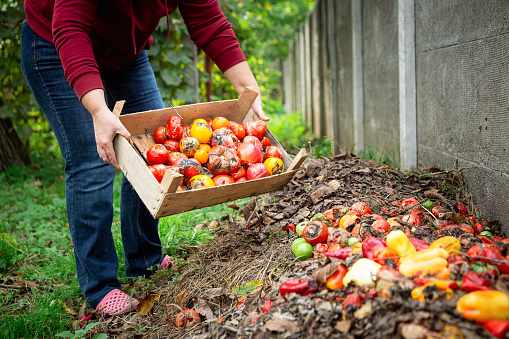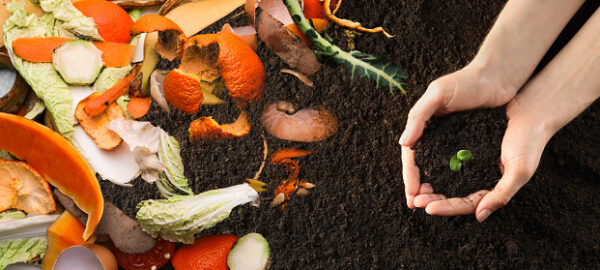Did you know about 40% of what farmers grow is thrown out? Our kitchen scraps are full of nutrients that could be put to good use.
The average person throws out so much waste that could be used to help plants grow!
Read our How to Compost guide for everything you need to get started.
Why Do You Need to know how to Compost?
Composting is a great idea for lots of reasons. It’s good for you, for your garden, and for the environment. The sooner you start composting, the sooner you will reap the benefits.
Aside from regular recycling and home cleaning, composting is another great way to keep your whole home clean, safe, and healthy.
So continue reading to learn how to compost the Sparkle and Shine way.
Money
Chemical fertilisers are expensive. Making your own compost is a way of capturing nutrients that your garden plants need without having to apply artificially-made fertilisers. Making your own compost is free so you save money.
You may need to condition your soil in order to improve its moisture retention and to create a better medium for plants to grow. Why buy compost when you can make your own.
If you pay for your water, pouring it on your garden can be expensive. It’s especially expensive if much of the water is lost by draining away. Compost rich soil retains moisture and so you get the full benefit of rainfall and watering.
Soil
Adding compost to your garden soil helps retain nutrients. Compost releases nutrients for the plants to use more slowly and safely than chemical fertilisers. This prevents the burning of tender plants that sometimes occurs with chemical fertilizers.
A soil that is rich in compost has a good texture for growing. It has air holes and a good balance between drainage and water retention. Fertile soil grows healthier and more productive plants, giving you better yields.
Sustainable
Much of the material that goes into a landfill could be composted and perform a useful function. Landfill costs the community a great deal of money. Waste collection and the cost of land can be much reduced by simply composting more.
Some Cities are starting to do this on a huge commercial scale. San Francisco diverts 80% of its waste from landfill and sells the compost. Why not keep some of that valuable resource for your own garden?
Composting also has a wider environmental impact. It reduces CO2 emissions by reducing the use of transport to move waste. It reduces the production of greenhouse gas, methane from landfill sites.
1. What Kind of Composter Do You Need?
You don’t need a special composter to make compost. There are some advantages to buying one.
You can simply pile organic material in a corner of your garden. It will break down but adding some straw or other courses material will help it compost faster. Turning it over periodically will also help.
Make Your Own Compost Bin
You can make your own compost bin by adapting a heavy-duty garbage can. Drill holes in it to all air to penetrate the walls of the can. Bolt a length of 2×2 timber to the inside wall.
Fill the can with a mixture of organic waste. Use grass, kitchen scraps, and yard waste.
Secure the lid and tip the can on its side. Roll the can to aerate and break up the compost. The length of timber will help break up the compost.
Plastic Compost Bin
Buy a plastic compost bin. This should be sited directly on the ground. These can be filled from the top and composted material removed from the base.
They are space-efficient because they are taller than standard garbage cans. It does take longer to produce compost as it is difficult to turn over the material.
Tumbler
A tumbler is a very efficient way of producing compost. The container has internal paddles to aid in turning the compost. It sits on a frame that allows you to tumble the contents regularly.
The combination of air and organic material makes composting more rapid. High temperatures in the material mean that it can work even in colder seasons. It’s also less attractive to pests and is largely odour-free.
2. What Can You Compost?
A composter uses nitrogen or carbon-based material. Try to achieve a balance between these two types of material.
Nitrogen-based materials include kitchen scraps, green leaves, tea leaves, coffee grounds, and grass clippings. The key is not to have too much of one thing. It is also recommended to mix it up with carbon-based material to a 50/50 ratio.
Carbon-based materials include plant stems, sawdust, shredded bark, straw, conifer needles, and shredded paper. It’s best to shred any bulky material. Use wood and sawdust sparingly as the carbon levels can be very high.
3. What Can’t You Compost?
Pests can be attracted by meat, fish, and bones. These materials are best avoided. Avoid pet manure in compost that may be used on food crops.
Some seeds can survive despite being composted so try to avoid adding them to the compost material. Perennial weeds can be spread when you use the compost. Similarly, plant diseases can be spread by composting infected plant material.
Don’t add any material to compost that may have been contaminated with pesticides. Lawn treatments can leave pesticides on grass clippings so don’t add clippings from the next few cuts to the compost bin.
4. How to Make Great Compost
Encourage worms and bacteria to enter your compost by sitting it on bare earth. Start with some twigs to help with drainage. Add the compost material in layers and alternate between dry and moist material.
If the compost seems too dry, add some water. Covering helps retain moisture but also stops it being washed out by rain. Use old carpet, plastic sheeting or a wooden cover.
You can make great compost without using an “activator”. If you want it fast, kick-start it with a commercially available composting activator.
5. How to Fix Compost Problems
Cover exposed fruit or vegetable matter with grass clippings to discourage flies. A small pile of grass clippings can be kept near the compost bin for this purpose. A little lime added to the surface will also do this.
Compost can produce some unpleasant odours. Reduce these by covering the compost with a mulch of grass clippings. Also, add some calcium to the mix to neutralise the smell.
Help a soggy compost bin by adding more carbon material. Break up matted green material and mix it with the rest of the compost material.
Get Composting
Composting is easy and rewarding. The satisfaction of producing your own, free compost is only exceeded by the pleasure your crops will give you. Follow this How to Compost guide and get composting today.
Read about more ways to reduce waste.


